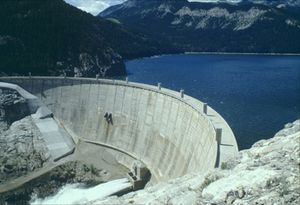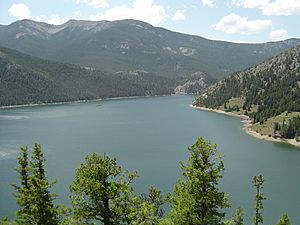Gibson Dam facts for kids
Quick facts for kids Gibson Dam |
|
|---|---|
 |
|
| Country | United States |
| Location | Lewis and Clark/Teton Counties, Montana |
| Coordinates | 47°36′12″N 112°45′39″W / 47.60333°N 112.76083°W |
| Purpose | Irrigation |
| Construction began | 1926 |
| Opening date | 1929 |
| Dam and spillways | |
| Type of dam | Concrete arch |
| Impounds | Sun River |
| Height | 199 ft (61 m) |
| Length | 960 ft (290 m) |
| Reservoir | |
| Creates | Gibson Reservoir |
| Total capacity | 96,477 acre⋅ft (119,003,000 m3) |
| Catchment area | 575 sq mi (1,490 km2) |
| Surface area | 1,296 acres (524 ha) |
The Gibson Dam is a large concrete dam located in Montana, United States. It sits on the Sun River, which flows into the Missouri River. This dam is about 60 miles (97 km) west of Great Falls, Montana, right at the edge of the Rocky Mountains. It was built between 1926 and 1929 by the U.S. Bureau of Reclamation (USBR). The main reason for building Gibson Dam was to help water about 93,000 acres (38,000 ha) of farmland in the Sun River Valley. This process is called irrigation.
Contents
Dam Details and Purpose
Gibson Dam is a strong concrete arch dam. It stands 199 ft (61 m) tall and stretches 960 ft (290 m) long. The base of the dam is 115 ft (35 m) thick, getting thinner towards the top, which is 15 ft (4.6 m) wide. In total, the dam contains a huge amount of concrete, about 167,500 cu yd (128,100 m3).
Gibson Reservoir
The dam holds back the river water, forming a lake called Gibson Reservoir. This reservoir can hold up to 96,477 acre⋅ft (119,003,000 m3) of water when it's full. At its highest level, the reservoir covers 1,296 acres (524 ha) of land. Its shoreline is about 15 mi (24 km) long, and it can be as deep as 195 ft (59 m).
Water Release and Irrigation
Water from the reservoir is let out through special openings. There are three release valves at the bottom of the dam. These can let out a combined 3,050 cu ft/s (86 m3/s) of water. There's also a special tunnel called a spillway, which has six large gates. This spillway can release a maximum of 30,000 cu ft/s (850 m3/s) of water, especially during floods.
The main job of Gibson Dam is to collect water from melting snow in spring. This water is then released during the dry summer months. This helps irrigate about 81,000 acres (33,000 ha) of land north of the Sun River and 10,150 acres (4,110 ha) south of the river. The water travels a few miles downstream to another dam, the Sun River Diversion Dam. From there, it goes into canals that carry it to farms.
Building the Dam: A Look Back
The idea for the Sun River Project, which included Gibson Dam, started way back in 1906. People in the area, especially in Great Falls, wanted to use water from the Sun and Teton Rivers to make dry land fertile for farming. Early plans were very big, even suggesting moving water from west of the Continental Divide. But eventually, the project focused on building two storage dams (including Gibson Dam), two off-stream reservoirs, a diversion dam, and several main canals.
Choosing the Site
The spot where Gibson Dam now stands was first identified as a great place for a dam in 1889. It's in a narrow mountain gap, perfect for holding back a lot of water. More detailed studies in 1911 confirmed this idea, and plans for the dam started around 1920.
Construction Begins
The main construction contract for Gibson Dam was given to Utah Construction Company in September 1926. The dam cost about $1.5 million to build. Gibson Dam was one of the first dams designed using a new method called the "trial-load method." This method used math to figure out how much pressure the water would put on the dam. This helped engineers design the dam very precisely, saving a lot of concrete and money.
Actual construction began in December 1926. First, workers cleared the site and dug out the ground. They built a wooden channel to move the river water around the construction area. Once the foundations were ready, concrete pouring began. The concrete was mixed about 1,500 ft (460 m) downstream and brought to the dam site by a small railway. Then, it was lifted into place using buckets on a cable system.
There were plans to generate electricity at the dam in the future. Two large pipes were installed for this purpose, and power lines were built. However, it was later decided that the reservoir wouldn't hold enough water to make electricity all the time. So, these plans were stopped, and the pipes were sealed. The dam was finished in December 1929, after three years of hard work. In 1938, gates were added to the spillway, which increased the reservoir's water storage capacity by 20 percent.
Stopping Floods
Gibson Dam plays a very important role in preventing floods. By holding back the Sun River's spring floods, the dam has saved an estimated $3,044,000 in flood damage between 1950 and 1999.
In 1964, western Montana had one of its biggest floods ever. A lot of snow melted quickly, and then heavy spring rains caused huge damage. During this time, there were rumors that Gibson Dam had broken. A pilot from the U.S. Forest Service flew over the dam and saw that water was flowing over the top of it. Even though a lot of water was going over the dam, it held strong. After this event, the dam was made even stronger so it could safely handle even more water flowing over its top if needed.
Future Power Plans
There is a new proposal to add a power plant at the base of Gibson Dam. A partnership called Gibson Hydro wants to build a 15 megawatt (MW) powerhouse. This plant would use the water released for irrigation to generate electricity. It's estimated that it could produce 42.9 million kilowatt hours of electricity each year. This would be a way to create clean, renewable energy from the dam's existing water releases.


